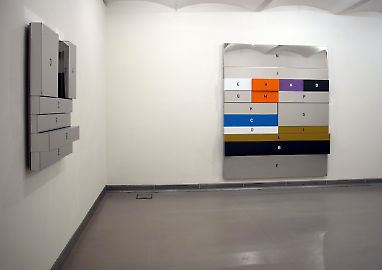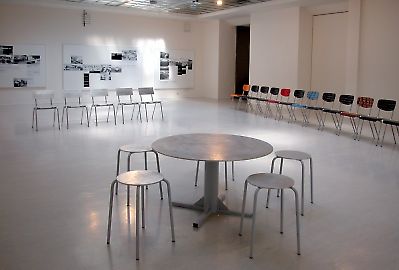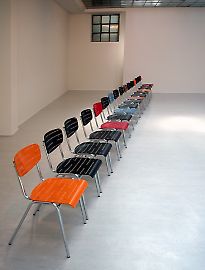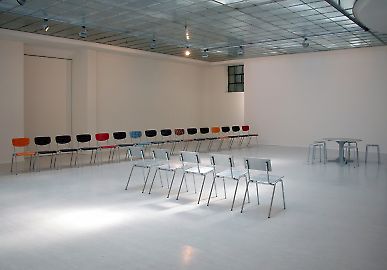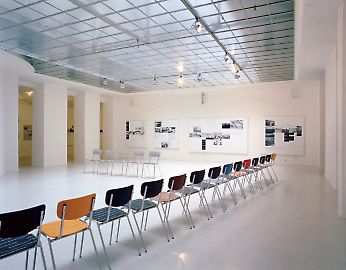Thomas Locher --
Since the end of the 1980s, Thomas Locher’s work has revolved around language and communication, around society and human action. In his text images he demonstrates the way language functions; sheds light on the rule that govern this, our main medium of communication; and explores the structures of power, authority, and hierarchy inherent in it. As a visual artist he is also concerned with the phenomenon of perception, with the reality that perception is impossible without concepts and that an understanding of images is always based on language. At the same time, he critiques his predecessors in the arts: whereas conceptual artists of the 1970s made clear connections between image and concept in the sense of strict definitions, Thomas Locher understands language to have multiple meanings and to be ultimately inscrutable.
The breeding ground for his works is the broad field of theories that analyze communication and human coexistence and action: linguistics; semiotics; philosophy of language; communication, social, and economic studies; system theory; psychology; psychoanalysis; gender studies; and advertising and mass media studies. His artistic position corresponds to all such theories that critically analyze systems, make implicit structures visible, and search out in norms the part that is different and in rules the part that is ineffectual.
When discussing works by Thomas Locher that treat sender, recipient, message, code, and context it is tempting to adopt the terminology of these sciences and theories. But his works are neither linguistic research nor theory turned into image. They are artworks, aesthetic unties unto themselves. Thanks to their rigorous design—at first glance, sober and austere, with the second, interspersed with humor—Thomas Locher’s reflections can be read without recourse to theory. He himself understands his works as “clever images that can still be enjoyed.” […]
Thomas Locher ‘s interest in systems of meaning, however, also extends to their subject matter, in particular their political implications and practical effects in the lives of groups and individuals—in general, his work seems to be motivated less by linguistics than by sociology. This inclination is expressed succinctly in his works based on the texts of national and international laws, [like] in the five panels Notstandsgesetzgebung and in the four works Human Rights. The texts are formulated as abstractions, but as the founding laws of a society they can change people’s lives and in practice they do so constantly. Thomas Locher juxtaposes them with questions and commentaries in colloquial language and thereby puts their clarity and authority in doubt.
Politics of Communication also bears the stamp of power structures. Thomas Locher uses photographs of office spaces to expose work hierarchies: classic designs for chairs stand alongside cheap mass-produced ones; sweeping desks contrast with identical workplaces arranged in rows. […]
Unambiguous statements, definitions and legal texts lay claim to validity […] and the sender always claims to be the authority that guarantees such validity. But, as Locher notes, „to understand [something] means to see it perspectivally, from many sides. That means to occupy as many places as possible from which the thing can be seen. That also means to occupy the place that belongs to someone else.“ Like Thomas Locher’s works based on a legal texts, Politics of Communication does not strive for disambiguation of statements or formal structures but for a plurality that implies a pluralism on the level of society. […]
Karin Schick, “Politics of Communication,” in: ed. Johann-Karl Schmidt, Politics of Communication, Fragmente der Notstandgesetzgebung, Knoten und Linien/Knots and Lines, Human Rights/The New Subject: The Refugee, quantum books, Ostfildern, 2003, no page.
*Editor’s note: Thomas Locher presented Politics of Communication directly on Rudolf Stingel’s aluminum foil cladding that had been “worked over” by visitors in the preceding exhibition.




